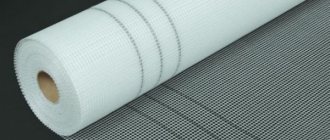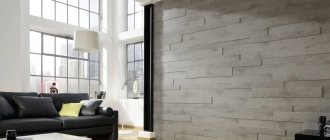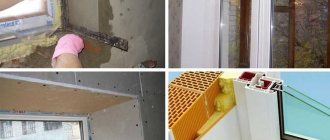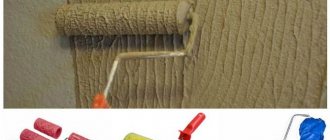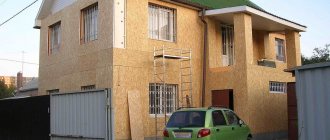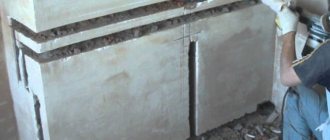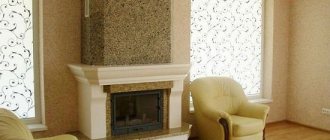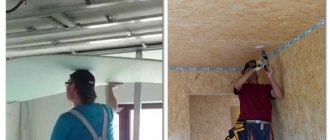Oriented strand board (OSB, English oriented strand board, OSB) is a sheet material consisting of glued thin wood chips. It is widely used in the construction of houses, for example, using frame technology, from SIP panels, as well as in the construction of roofs and partitions indoors.
Correctly plastering walls made of OSB boards for subsequent decorative finishing or painting is not difficult; this technology will be discussed below.
Is it possible to plaster OSB?
Oriented strand boards are used for interior decoration and facade cladding. The decorative design of surfaces involves painting, applying plaster, gluing wallpaper, and tiling.
Plastering OSB is permitted in accordance with building codes. Finishing is necessary to increase the durability of the coating, give it moisture-resistant characteristics, increase the strength of the base, and noise and heat insulation of premises. However, it is important to select materials in accordance with operating conditions (high or medium air humidity).
The protective coating for OSB must meet the following requirements:
- waterproof;
- resistance to mechanical damage;
- resistance to temperature changes;
- vapor permeability;
- environmentally friendly composition;
- high level of fire safety;
- long-term operation;
- maintainability;
- resistance to mold and mildew;
- non-exposure to ultraviolet rays;
- light weight of the slab (does not weigh down the supporting structure);
- affordable price;
- simple application of the plaster mixture;
- the ability to do the finishing yourself.
Preparatory work
When preparing for work, it is necessary to analyze how the sheets, that is, the basics, will be fastened. This must be strictly carried out in accordance with the requirements of building regulations, and it is not recommended to independently reduce or increase the number of elements.
OSB boards must be fastened firmly enough to prevent them from moving. The presence of vibration and mobility of the base are the main negative factors affecting any structure. It is important to know that the use of additional fasteners to strengthen the structure cannot be used.
OSB is sheets made from wood chips. By themselves, they absorb water, and the plaster marking is rejected. Without preparation, the surface will become covered with a network of cracks, and the solution will gradually peel off. Creating a special insulating overlap between the slab and the covering layer will help avoid this problem.
There are 2 options for insulating coating:
- Fastening the insulation.
- Upholstering the surface with kraft paper or cardboard impregnated with bitumen.
Why do OSB panels need to be plastered for external and internal use?
OSB plaster is necessary for interior and exterior decoration to solve the following problems:
- creation of additional noise and heat insulation of the building;
- formation of a monolithic base for decoration;
- correction of joints, seams, cracks and surface defects;
- embodiment of the author's design of facades and interior walls;
- increase in service life after repair;
- protection of the coating from moisture, sunlight, insect pests;
- prevention of mold and mildew;
- reducing the cost of heating the room due to the use of insulation during the plastering process.
Is it allowed to cover with OSB plaster?
If OSB is left without a protective layer, its service life will decrease significantly, since moisture and other factors will spoil the material. It may swell, darken and split. Plastering OSB boards will help neutralize all these negative consequences. After work, the surface can be decorated with any finishing material:
- Paint (it is important to create a perfectly smooth base layer of plaster without defects).
- Wallpapering (used only indoors).
- Application of decorative panels. The method is not cheap, and it does not provide 100% OSB protection.
- Using siding (exterior only).
- Tile suitable for indoor spaces.
- Decorative rock. An expensive pleasure, a beginner cannot cope with such work.
- Decorative plaster.
Is it possible to plaster OSB boards? Yes, because plaster has a number of positive properties. For example, it is not afraid of temperature changes, is moisture resistant, and has good mechanical strength. In addition, it is vapor permeable, environmentally friendly, fireproof, and repairable. The cost of finishing is low, it does not load the wall structure and is easy to use. It turns out that when using plaster on OSB, you can perform the following tasks: create an additional noise and heat insulation layer, protect the panel and hide seams and other defects, make the building beautiful and presentable.
Positive and negative sides
Plastering OSB boards has the following advantages:
- leveling the base;
- increasing the durability of the design;
- increasing the strength of walls and facades;
- the ability to change the shade of decorative trim;
- the coating is not damaged by wet cleaning;
- simple technologies for applying the mixture;
- the ability to repair sections of facades, interior walls, etc.
When deciding whether it is possible to plaster OSB boards, the disadvantages of the finishing material are taken into account:
- Products are produced in different classes; when purchasing, it is important to study the composition of the slabs. The blocks should not contain synthetic resins.
- Some types of sheets should be covered with plasterboard or other finishing materials.
- To maintain a comfortable atmosphere, it is necessary to install ventilation systems.
- After plastering, additional decorative finishing may be required.
OSB surface preparation
OS boards may be dusty and dirty. It is necessary to sand the surface, remove dust and dirt stains. Since wood material cannot be washed, special products containing organic solvents, such as white spirit, are used for cleaning. The seams are sealed (the sealant for OSB is elastic, since the slab must have an expansion gap on the sides), primed and puttied to obtain a flat surface.
Sealing seams between slabs with sealant
What plaster is used for OSB boards
Mixtures based on the type of base are divided into the following compositions:
- mineral;
- elastic;
- polymer;
- decorative, etc.
According to the purpose of the plaster, it can be:
- roughing (leveling);
- finishing (for decorative finishing);
- thermal insulation;
- noise-absorbing;
- X-ray protective;
- waterproofing, etc.
According to the scope of application, materials are divided into the following types:
- for interior work (in heated rooms);
- external (for facade and interior decoration);
- universal.
The compositions differ in the binding components, type of filler (from natural or artificial materials) and functional additives.
Mineral
The slabs can be plastered with a mineral composition, which can be based on gypsum powder, clay, cement or lime. The advantage of the mixture is increased strength, environmental friendliness of the components, good vapor permeability, and resistance to temperature changes. The plaster is non-flammable, affordable, and resistant to ultraviolet radiation. The material is repairable, durable, frost- and water-resistant.
The disadvantage of the finishing agent is low elasticity. This product is not recommended for treating walls that are subject to mechanical stress due to the risk of cracking. Mineral compositions are sold by manufacturers in finished form or as a dry powder. When preparing the solution, the proportions of the ingredients are taken into account. For facade finishing, gypsum-based mineral mixtures are not used.
Elastic
This plaster mass is sold ready-made. The binding ingredients in the product are acrylic resins. The advantage of the material is increased ductility, which ensures stretching of the composition under load on the base.
The plaster is waterproof, has a wide range of shades, is durable, has good adhesion, and is easy to apply. The material is recommended for finishing new houses and buildings in earthquake-prone regions. The coating is repairable. However, it is necessary to take into account the low vapor permeability of the plaster mixture, low resistance to ultraviolet radiation, and high cost.
This group of materials also includes super-elastic silicone compounds with high strength and durability.
This product is expensive and difficult to clean after hardening. Elastic mixtures can be used to plaster OSB boards indoors.
Polymer
This plaster belongs to the decorative variety and is used for applying the finishing coating. In the class of polymer mixtures there are silicone, siloxane, acrylic and polymer acetate. The advantages of this type of product are breathability, increased heat and sound insulation of the room, durability, environmental friendliness of the composition, resistance to fungus and mold.
The plaster is waterproof; polymers are used as binding ingredients. The material is offered ready-made or in the form of a dry powder. The instructions indicate the proportions for preparing the mixture and the type of reagent. The cost of such plaster is higher than that of mineral materials.
Polymer plaster is made with 2 types of bases:
- water soluble;
- soluble in organic diluents.
Decorative
For decorative finishing on OSB wall panels, factory-made plasters are used.
For work you can choose the following compositions:
- structural;
- stone (mosaic, marble);
- textured;
- colored;
- Venetian;
- flock.
Decorative plaster is applied in several layers, the texture is reproduced through the presence of different fillers and the use of special tools (texture rollers, hard brushes). On a cement plaster base, you can imitate stone or brickwork. Bases with a single-color coating are created after putting slabs in 2-3 layers and painting the surface.
Textured plaster mixtures are distinguished by the presence of fillers (granite, marble chips, etc.) that change the texture of the material. The advantage of plaster is its plasticity, lack of shrinkage after drying, strength, resistance to temperature changes, and easy application to the base.
The textured composition can be used to correct surface unevenness. You can change the saturation of the shade using coloring pigments, mica, pearlescent particles, etc. The material helps to enhance the heat and sound insulation of the room.
The compositions do not contain harmful substances, so the mixture is universal for finishing residential and public premises and outdoor work.
Textured materials are presented mainly in natural tones and other natural shades. It is optimal to create an imitation of a wood base using golden, brown, ocher colors. Neutral white, gray and steel materials are used in public spaces. Light colors are optimal for decorating bedrooms and small rooms.
According to the type of texture, textured plasters are divided into the following subtypes:
- "bark beetle";
- under brick;
- with imitation silk;
- travertine, etc.
Manufacturers produce bark beetles in various shades and with different granule sizes. The material belongs to the finishing variety and is applied at the end of the finishing work. The coating is intended for cement, stone, plasterboard, and wooden substrates. In finishing you can combine several mixtures of granule type and shades. The material is suitable for internal and external processing.
Brick plaster allows you to reproduce an imitation of such masonry. The composition can be used in rooms decorated in grunge, boho, loft, and minimalist styles.
Plaster with imitation silk fabric helps to visually expand the size of the room. In addition to the special mixture, you will need a roller and a spray bottle. The applied plaster is smoothed with tools. As a result, a seamless coating is formed, which is optimal in baroque, classic, rococo, renaissance, art nouveau, and Provence style interiors.
Plaster with a travertine texture is used to imitate stone surfaces. The color range is natural: brown, golden and sandy tones. The coating is created from mixtures of 2 shades, applied in several layers. A texture is created on the formed plaster base. At the end of the work, the composition is coated with wax to improve aesthetics and reduce hygroscopicity characteristics.
Features of plastering OSB boards
Internal and external plastering are no different. However, you need to take into account some characteristic features:
- Choose a plaster composition depending on where the work will be carried out: outdoors or indoors.
- The facade can be plastered only in dry weather, without wind. Stop work if the air temperature rises above +35°C. In case of precipitation, the wall should be covered with polyethylene. The composition must have high moisture resistance, be resistant to frost and ultraviolet radiation.
- For interior work, normal indoor humidity and absence of drafts are required.
- To prevent cracks from appearing on the plastered surface, you should not dry it with heat guns, fans or heaters.
- Before starting plastering work, the electrical wiring must be completely disconnected.
What tools will you need?
It is advisable to prepare the tools in advance. If you use a dry mixture, you need a mixing container. Various spatulas, graters and trowels, rollers and brushes, sealants, adhesives, solvent and primer, a level, staples and a construction stapler, masking tape, a sanding machine, rags and a drill with a special mixer attachment will be useful.
How to properly prepare the surface
For best results, you need to prepare the surface. Preparation usually consists of the following steps:
- Cleaning. If time has passed since installation, the OSB must be cleaned of dust, stains and dirt to increase adhesion. Wipe the surface with solvent, do not wet it with water. Acetone can be useful for removing stains and a vacuum cleaner for dust.
- Sealing joints. Carefully seal the gaps in the joints using sealant or polymer elastic putty (type of work - facade). After this, go along the edge of the sheet with a spatula.
- Grinding. Irregularities must be removed using sandpaper or a grinding machine.
- Primer. Improves finish color and adhesion. You don’t have to do this if a cement solution is used as plaster.
- Fastening reinforcement. Under the cement-sand plaster, a reinforcing mesh must be secured with a stapler or wide self-tapping screws. At the outer and inner corners of the walls, corners with mesh are also secured with staples.
Important! The ends, joints and surfaces are thoroughly sanded using sandpaper.
Methods for plastering OSB boards outside the house
You can choose the option of how to plaster an OSB board from several finishing technologies:
- traditional method without insulation;
- with insulation;
- using plasterboard sheets.
Traditional way
When plastering without insulation, it is recommended to use a membrane material with high vapor permeability, a broaching mesh to reinforce the base, glue and a plaster composition in the finishing.
The work is carried out in stages:
- The membrane material is fixed to the surface using a stapler.
- Membranes can be replaced, if necessary, with craft paper, bitumen cardboard or roofing felt.
- The canvases are joined using an overlapping method of 10 cm using glue or double-sided tape.
- A reinforcing mesh is fixed on top.
- Then the adhesive base is applied in 2 layers to securely fix the reinforced mesh.
- After drying, the base is sanded, then a primer mixture is applied.
- For plastering, it is recommended to use elastic mixtures, because... These materials are less susceptible to cracking.
- It is important to treat the ends of the slabs for the durability of the finish.
Insulation and plastering outdoors
Insulating facades before plastering allows you to save more space indoors and apply the plaster mixture more reliably and more durablely. The recommended insulation option is sheet foam, which is glued to the panel.
After the adhesive base has dried, the material is fixed to the surface using dowels. Joints are formed between the foam blocks, which are filled with polyurethane foam. The remains of the frozen mass are cleaned off after drying. The next layer is to apply the adhesive solution to the mesh. Plastering is carried out after the glue has dried.
Using drywall
Plaster on the OSB board on the facade can be applied after fixing the drywall. GKL are used as additional insulation, leveling the base of the material. Together with the OSB panel, plasterboard will improve the sound insulation characteristics in the premises and prevent the risk of fire in the building. The materials are secured using self-tapping screws. Then putty and plaster are gradually applied to the base. Drywall is universal and suitable for finishing with different types of plasters.
Preparing OSB for plaster
Dust and dirt can cover the slabs. They will interfere with high-quality adhesion, so it is necessary to remove all dirt and imperfections. Since the surface cannot be wetted, white spirit is suitable as a cleaner. The joints must be sealed with sealant. An elastic composition is used for this purpose.
The final stage will be priming. The layer will improve adhesion and saturate the surface. It will not absorb moisture from the solution and it will not dry out. The primer is applied with a roller and brush.
Features of plaster on OSB indoors and on the facade of the building
Plastering on OSB boards is carried out on facades and inside buildings. When performing work outside a building, it is important to choose days with calm, dry and warm weather. The site is covered with a canopy from the sun's rays and possible precipitation. The optimal air temperature range is +5…+35°C.
Working indoors is more comfortable; air humidity should not be higher than 65%; drafts are prohibited during wall finishing. It is not recommended to use fans and heating devices to speed up the drying of panels.
If these requirements are violated, cracks may appear after plastering. Electrical wiring in the room must be de-energized before starting work.
Difficulties when plastering OSB
Despite the wide range of applications of OSB boards in the construction industry, even such a material has limitations. And since the base of the material is wood, the panels are able to absorb moisture. When applying a plaster mixture enriched with water, the layer becomes covered with cracks during the drying stage or after hardening. But for OSB boards, direct contact with moisture is not beneficial. Ultimately, the wood material itself cracks, causing its service life to be significantly reduced.
Note!
OSB panels have a low level of adhesion to mortar due to their smoothness.
Step-by-step plastering technology
Plastering is carried out in stages:
- After installing the panels, the surface of the walls is checked.
- Stains are cleaned, rough spots are sanded.
- The areas can be finished off with a vacuum cleaner.
- The joints are coated with sealant.
- The seams are puttied and leveled.
- The wall is dried and coated with primer using a roller or brush.
- After drying, vapor barrier materials (roofing felt, membrane fabric, etc.) are applied to the soil and fixed using a stapler.
- A layer of adhesive base up to 3 mm thick is applied on top.
- Then a reinforcing fabric is applied, straightened, and pressed into the adhesive base.
- After 24 hours, a layer of adhesive mixture is re-applied on top of the mesh for leveling and dried.
- Then priming is performed using a product suitable in composition.
- After the primer has dried, finishing plastering work is carried out.
- The plaster is applied using the chosen method to form the optimal texture on the surface.
- The finish is dried, painted or covered with clear varnish.
Plaster on OSB
Now that the preparation is complete, let's look at how to plaster OSB step by step:
- Puttying the joints and drying the wall.
- A vapor barrier is applied to the surface and mounted on a stapler.
- Using a spatula, apply an adhesive layer no more than 3 mm thick. This could be Ceresit ST85.
- A reinforcing mesh is applied to it. No folds should form. Using a spatula, the mesh is embedded in the entire layer.
- After 24 hours, you can apply a 1 mm layer of glue to level the surface and wait until it dries.
- The surface is primed in a similar way.
- After drying, you can apply the final plaster layer.
This principle is used to plaster OSB panels. The work is not difficult, but requires care and following certain instructions. So, now everyone knows whether it is possible to plaster OSB and how to do it correctly. All that remains is to choose the plaster and start work.
Safety precautions when performing plastering work
When plastering, it is important to comply with safety requirements:
- Work is carried out only in special clothing, a respirator, gloves, safety glasses, and a hat.
- Finishing is not done from the stairs, so you can use a table or cabinet. The scaffold must be placed firmly on the floor covering.
- If your health worsens during the procedure, it is recommended to stop plastering.
- Work is performed by persons over 18 years of age.
When deciding whether it is possible to plaster OSB in a room with open windows, experts recommend taking into account the characteristics of the finishing material. The composition applied to the walls must dry without drafts or temperature changes. Otherwise, it will quickly crack and lose its aesthetics.
Why do panels need to be plastered?
If an OSB board used for outdoor work or inside unheated rooms becomes saturated with moisture, the wood will defrost in winter and swell in summer. The result will be a loss of strength, deformation, and swelling of the material.
The chemicals that bind wood in OSB do not tolerate temperatures below -30 degrees. If you apply plaster, it will create a protective barrier and prevent damage to the material. The plaster coating also performs the following functions:
- strengthening the thermal and sound insulation of the building;
- preventing drafts;
- formation of a monolithic coating without seams or defects;
- hiding damage, pits and chips;
- giving the wall a more aesthetic appearance;
- eliminating the need to make repeated repairs over many years;
- the ability to dye and change color at the request of the owners;
- makes it easier to clean or dry surfaces.
Polymer compositions for plastering
The fastest way to apply plaster to the surface of OSB boards is to use polymer compositions based on acrylic or latex synthetic resin. They are available in the form of ready-made solutions. After opening the container, everything must be used very quickly. Because the plaster sets quickly and it is impossible to dilute or restore the original consistency.
Now let’s figure out how to plaster an OSB board in this way.
- Grinding. To do this, choose coarse-grain sandpaper. At the same time, all elements that protrude beyond the surface of the slab and do not connect well with it are removed.
- Primer. After sanding, the slab is cleaned of dust and covered with deep penetration primer intended for wooden surfaces. This will not only protect the wood from moisture, but will also increase adhesion, which means the plaster solution will be easier to apply.
- If there are any unevenness on the OSB board or there are gaps at the joints, then after the soil has dried, they are treated with acrylic sealant. The composition is sent into the uneven area and carefully leveled with a spatula. This process will allow you to use less polymer plaster.
- Plastering. After the sealing layer has dried, begin applying the finished composition. The solution is applied to the wall and leveled to obtain a layer 5 mm thick. You need to work quickly.
Advantages and disadvantages of aerated block putty without plaster
Puttying walls without prior plastering has a number of advantages:
- saving building materials that are not spent on plastering;
- saving time;
- reduction of labor intensity of work;
- reduction of financial costs;
- improving the permeability of walls to water vapor, which increases the comfort of the indoor microclimate without the use of forced ventilation.
There are also known disadvantages of the described technology, which boil down to applying 2-3 layers of putty in the case of maximum permissible differences in wall surfaces. The complexity and time of finishing work increases accordingly. Another nuisance may be the appearance of traces of gas block joints on a fully finished wall. Moreover, according to the “law of maximum meanness”, this will happen within a short time after the object is handed over to the customer.
What can be used
There are compositions that are specially designed for plastering OSB boards, although they are rarely found on sale. Most funds are considered universal and are divided according to other principles.
For example, according to the properties and specific application of plaster there are:
- leveling;
- finishing;
- special: noise-reducing, waterproofing, etc.
Usually finishing plasters are chosen for cladding, because the slabs do not need leveling. Plastering products are sold ready-made or require dilution with liquid. In addition, building mixtures can have different compositions: some are suitable only for outdoor work, others for indoor work, and others are used in any conditions. The difference in quality and function is provided by the plaster base, as well as fillers and additives.
Polymer compositions
Plasters with polymer binders are a material ideal for processing OSB. They are based on synthetic resins or other polymers that provide high strength and long service life.
The most popular materials in the group are:
- Silicone plaster. It is very plastic, easy to lay on the surface, resistant to moisture, and at the same time vapor permeable. Has antiseptic properties. Available in white and pigmented versions.
- Silicate plaster. Contains liquid glass, which after hardening provides the coating with special strength. The plaster is not afraid of water, does not disturb the microclimate in the room, and helps to destroy fungus. The service life of the material is 30–50 years, but its price is quite high.
- Acrylic plaster. Made on the basis of acrylic resin, suitable for interior use only. It has less high strength than other representatives of polymer compositions. It can be easily tinted or painted after hardening and is inexpensive.
- Siloxane plaster. It is a modification of a silicone mixture based on siloxane - silicone with a simplified molecule. It has less pronounced moisture resistance than silicone and is gradually destroyed by ultraviolet radiation. The service life of such plasters is 3–5 years.
- Polymer cement plaster. This is an improved cement-sand mixture enriched with polymers. Due to changes in composition, the material becomes elastic, gains greater bending strength, shrinkage, and gains excellent adhesion to building materials and abrasion resistance.
To treat OSB indoors, you need to buy only environmentally friendly water-based compounds. For facade work, plasters based on organic solvents are more suitable, since their strength and moisture resistance will be higher.
Decorative plasters
Materials of this group are intended not only for protection, but also for creating a decorative layer on OSB boards. They are suitable for external and internal use and contain various fillers. The main types of decorative plasters that can be used when working with oriented strand boards:
- Structural. Includes impurities of quartz and small stones. When applied to a base, it produces a rough surface. When facing OSB with some types of structural plasters, multi-colored spots appear.
- Venetian. Contains fine marble chips. After drying, the base will resemble stone, which looks noble and very beautiful.
- Textured. They may contain a wide variety of impurities: cellulose, pebbles, mica, silk, pieces of fabric.
- Flock. They consist of three layers: base, flock (with pieces of dried acrylic) and varnish. They are quite expensive and difficult to use.
Mineral plaster
The basis of such plasters are cement, gypsum, lime, clay. In their pure form, they are not suitable for working with OBS, since they do not have the proper ductility and are afraid of impact. If you accidentally hit the wall, a whole piece of plaster may fall off the slab. When the building vibrates, the layer can also crack. Gypsum mixtures are very sensitive to moisture and are not suitable for outdoor work or wet rooms. The advantages of mineral plasters are:
- vapor permeability;
- environmental friendliness;
- strength (under static loads);
- frost resistance;
- maintainability;
- durability;
- affordable price.
Insulation and plaster
If you don’t have time to lay a large number of balls, use a different covering method. The role of thermal protection is performed by polyurethane foam and polystyrene in the slabs. These sheets are strong and water-repellent. Attach the material firmly to the base. Remove dirt and microparticles, eliminate moisture and grease. You can wipe the sheets with white spirit to de-oil the top ball.
Grease stains and dirt reduce the level of adhesion of insulation to OSB sheets.
The low weight of these insulating materials guarantees adhesive-based installation. To fix the heat insulator, use specialized glue for exterior use.
Be careful when choosing glue: look in the instructions for information that it is used for polyurethane foam and polystyrene.
Apply a thin ball of plaster over the insulation. Place reinforcing fiberglass on the still wet layer and press it in to even out the mixture. Place a portion of the solution on top after drying to cover the areas where the mesh is visible. Rub the surface dry and paint with acrylic paint.
How and why to plaster internal walls made of OSB
Oriented strand board (OSB), also known as OSB (OSB or OSBI), is perfect for construction. These slabs are increasingly used in house construction. This is especially true for the construction of frame houses. They are used both for cladding exterior facades and for arranging interior spaces inside. Therefore, the question of which method to prefer for interior decoration is relevant for every home owner.
Main types of interior decoration
Various methods can be used to decorate interior spaces whose walls are made of OSB. The choice is always up to the owners. A short list of finishing works that are suitable for OSB is given below:
- wallpapering
- painting
- varnish coating
- decorative putty and decorative plaster
- gluing tiles or ceramic tiles
You can learn about all finishing methods in the article: methods of finishing surfaces from OSB sheets in the house.
All of the listed types of finishes have one thing in common. The OSB surface must be properly prepared before the final finishing coat is applied.
There is essentially only one weak point of oriented strand boards. This is the ability to absorb and gradually accumulate moisture. Over time, the entire slab or part of it swells and deforms. Therefore, the OSB surface must be insulated from exposure to high humidity. And here many people have a question: is it better to putty OSB walls or cover them with a layer of plaster?
Initially, the puttying process is used to seal seams between slabs and to level walls. This layer serves as the basis for applying paint, wallpapering partitions and, oddly enough, for the finishing layer of plaster. So the conclusion is quite definite: putty is an element of rough finishing of premises.
So it is quite possible to plaster interior walls made of OSB. This, along with others, is a fairly common finishing method that is often used by designers. It should be added that the use of a conventional sand-cement mixture in this case is not recommended. There are special types of plaster that are designed for interior work with OSB panels.
Tools for work and applying plaster
In order to efficiently complete all assigned tasks, you need to prepare a list of materials and consumables in advance:
- container for mixing plaster (if it is a dry mixture for dilution with water);
- spatulas of different sizes;
- trowel, grater, grater;
- short-haired brush and roller;
- primer;
- glue;
- masking tape;
- sealant;
- stapler with staples;
- grinding machine;
- solvent;
- drill with mixer attachment;
- rags;
- construction level.
Preparing OSB for plaster
If a lot of time has passed after fixing the OSB, the surface of the boards may become covered with dust, dirt, and stains. The material must be thoroughly cleaned, otherwise adhesion to the plaster will be reduced. It is best to wipe the surface with white spirit or another solvent so as not to wet it with water. Indoors, you can clean the walls with a vacuum cleaner, and selectively wipe off stains with acetone.
Next, the joints between the plates are sealed with a sealant, choosing a composition with increased elasticity (acrylic or silicone). It is highly elastic compounds that will allow you to maintain expansion gaps on the sides. If there are unevenness, scars, or other defects on the slabs, they are removed using a grinding machine or sandpaper. Afterwards, acrylic primer is applied with a brush or roller in 2 layers with complete intermediate drying. Instead of such a primer, you can use a primer with fine quartz chips, which improves adhesion.
Attaching the insulation
To install insulation outside the premises, instead of polystyrene foam, you can use mineral wool. After attaching the roll insulation and gluing the reinforcing mesh, the base is primed and then plastered.
For interior work, polystyrene foam is used mainly, which is glued directly to a suitable adhesive composition in this way:
- The OSB surface is degreased and dirt is removed.
- The adhesive composition is applied with a spatula.
- The insulation is securely pressed to the glue.
- Wait for the glue to dry.
- The joints are reinforced with tape with a self-adhesive base.
Fastening the upholstery
This stage involves coating the joints between the sheets of insulation with sealant, as well as laying cardboard and kraft paper impregnated with bitumen and securing them with staples. For the purpose of additional insulation, these materials can be used as a supplement to traditional insulation or instead of it as a more economical option.
The final plaster layer is applied with spatulas of the required size. If decorative plaster is used, the surface is formed according to the selected effect. The dried layer is painted or varnished. Working with OSB boards is not difficult, but it requires care, adherence to technology and accuracy at every stage.
Plaster surface
The plastering process is carried out using standard technology, with a few exceptions.
- Plaster is applied using spatulas, since the surface is subject to vibration; throwing the mortar with a ladle will be problematic;
- Plastering on an OSB board is carried out in layers - it is necessary to “sink the reinforcing network into the first layer, let it dry and only then continue work.
Decorative plaster on OSB makes it possible to give a frame building a monolithic appearance, making it as similar as possible to a brick structure. You can get more information on this topic by watching the video in this article.
Additional Information:
OSB boards are widely used in frame house construction. Those located outdoors require protection from external atmospheric influences. Inside residential premises, the surface is finished in different ways: wallpaper is glued, painted, varnished.
When using some options, it is necessary to putty the OSB in order to create a perfectly even base and protect the wood from the harmful effects of the products used and moisture.
When working with OSB boards, first of all you need to remember that more than 90% of these products consist of wood. Therefore, high-quality finishing of OSB boards is associated with the use of materials typical for working with solid wooden surfaces. The slabs lend themselves to almost any finishing: they can be glued, painted, puttyed, varnished and even, subject to certain rules, plastered. All processing methods have their own characteristics, so each one should be analyzed separately.
Plaster, in this case, is used to create the last layer, which largely determines the design of the premises. These mixtures are called decorative plaster. For wooden surfaces, it is recommended to use compounds that have high adhesion.
We are talking about polymer-based plaster mixtures.
A layer of such plaster “breathes” and prevents the formation of fungi and mold. The plaster layer helps to significantly reduce sound transmission and retain heat.
How to apply decorative plaster on an OSB board? It is environmentally friendly and absolutely safe. A wall covered with plaster looks absolutely uniform. Joints between slabs and other defects are hidden.
This coating will last more than twenty-five years.
- the surface must be coated with an adhesive compound before carrying out work;
- the solution applied to the surface with a spatula should not be thinner than three millimeters;
- use of reinforcing mesh after applying the first layer;
- covering the surface with an adhesive composition after the first layer has dried.
The second method is plastering directly on the sheets of external cladding of the house. Unfortunately, if you are not a fan of the fakferkh style (when simulating fakferkh, the seams are covered with flashings), then this method of finishing can be considered solely as temporary. As practice shows, within 5-7 years, even if everything is done efficiently and correctly, cracks will appear at the joints of the external cladding sheets, which will spoil the appearance of the facades.
But plastering on OSB sheets for external cladding is an excellent way to take a “break” and save up funds for finishing with facing bricks, fiber cement siding, thermal panels with clinker finishing or other high-cost materials.
Frame houses are a quick and affordable way to acquire your own home. But such buildings require a more careful selection of materials to perform insulation and decorating work.
Those who choose plastering are wondering whether to lay plaster on an OSB board on the facade or not, and what compositions are best to choose?
Oriented strand boards (OSB) must be protected from external negative influences. Therefore, decorative finishing should have the following advantages:
- Resistant to high humidity.
- Tolerance of sudden and frequent temperature changes.
- Mechanical reliability.
- Heat and sound insulation properties.
- Affordable price.
- Duration of operation.
- Light weight.
Therefore, to the question whether it is possible to plaster an OSB board, the answer is definitely possible and necessary, since this type of finishing has all the listed characteristics. The main thing to remember is that wood absorbs moisture quickly and a lot, even if it is coated with a moisture-repellent composition.
Before plastering the base, it must be protected with a special layer that will not allow moisture to pass through from the solution. This layer can be bitumen cardboard, paper-based roofing felt, kraft paper or an elastic polymer coating.


